engine JEEP RENEGADE 2014 1.G Owner's Guide
[x] Cancel search | Manufacturer: JEEP, Model Year: 2014, Model line: RENEGADE, Model: JEEP RENEGADE 2014 1.GPages: 212, PDF Size: 17.48 MB
Page 70 of 212
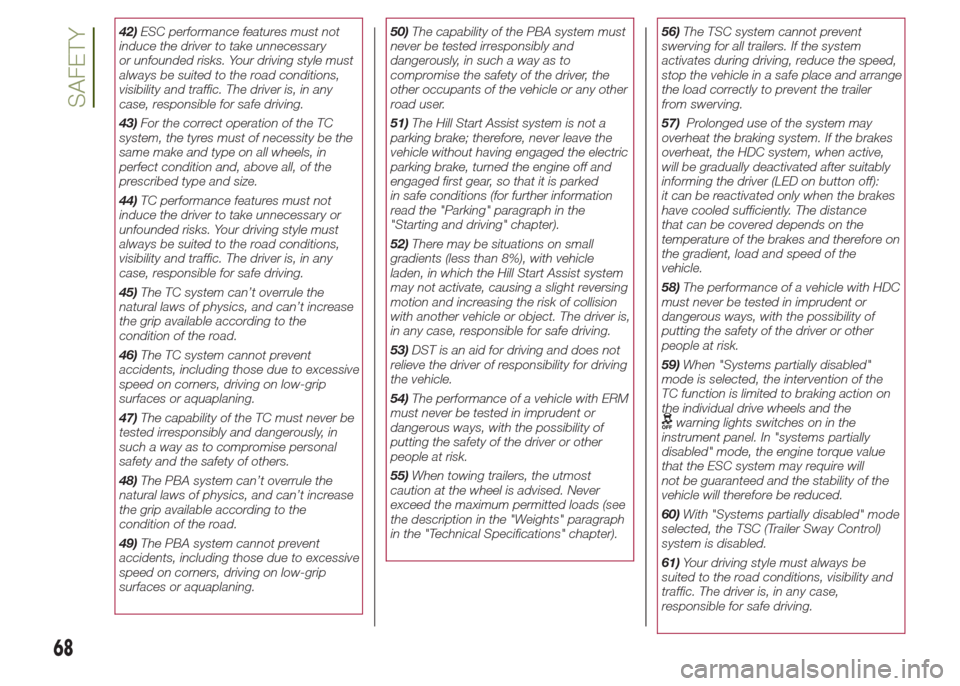
42)ESC performance features must not
induce the driver to take unnecessary
or unfounded risks. Your driving style must
always be suited to the road conditions,
visibility and traffic. The driver is, in any
case, responsible for safe driving.
43)For the correct operation of the TC
system, the tyres must of necessity be the
same make and type on all wheels, in
perfect condition and, above all, of the
prescribed type and size.
44)TC performance features must not
induce the driver to take unnecessary or
unfounded risks. Your driving style must
always be suited to the road conditions,
visibility and traffic. The driver is, in any
case, responsible for safe driving.
45)The TC system can’t overrule the
natural laws of physics, and can’t increase
the grip available according to the
condition of the road.
46)The TC system cannot prevent
accidents, including those due to excessive
speed on corners, driving on low-grip
surfaces or aquaplaning.
47)The capability of the TC must never be
tested irresponsibly and dangerously, in
such a way as to compromise personal
safety and the safety of others.
48)The PBA system can’t overrule the
natural laws of physics, and can’t increase
the grip available according to the
condition of the road.
49)The PBA system cannot prevent
accidents, including those due to excessive
speed on corners, driving on low-grip
surfaces or aquaplaning.50)The capability of the PBA system must
never be tested irresponsibly and
dangerously, in such a way as to
compromise the safety of the driver, the
other occupants of the vehicle or any other
road user.
51)The Hill Start Assist system is not a
parking brake; therefore, never leave the
vehicle without having engaged the electric
parking brake, turned the engine off and
engaged first gear, so that it is parked
in safe conditions (for further information
read the "Parking" paragraph in the
"Starting and driving" chapter).
52)There may be situations on small
gradients (less than 8%), with vehicle
laden, in which the Hill Start Assist system
may not activate, causing a slight reversing
motion and increasing the risk of collision
with another vehicle or object. The driver is,
in any case, responsible for safe driving.
53)DST is an aid for driving and does not
relieve the driver of responsibility for driving
the vehicle.
54)The performance of a vehicle with ERM
must never be tested in imprudent or
dangerous ways, with the possibility of
putting the safety of the driver or other
people at risk.
55)When towing trailers, the utmost
caution at the wheel is advised. Never
exceed the maximum permitted loads (see
the description in the "Weights" paragraph
in the "Technical Specifications" chapter).56)The TSC system cannot prevent
swerving for all trailers. If the system
activates during driving, reduce the speed,
stop the vehicle in a safe place and arrange
the load correctly to prevent the trailer
from swerving.
57)Prolonged use of the system may
overheat the braking system. If the brakes
overheat, the HDC system, when active,
will be gradually deactivated after suitably
informing the driver (LED on button off):
it can be reactivated only when the brakes
have cooled sufficiently. The distance
that can be covered depends on the
temperature of the brakes and therefore on
the gradient, load and speed of the
vehicle.
58)The performance of a vehicle with HDC
must never be tested in imprudent or
dangerous ways, with the possibility of
putting the safety of the driver or other
people at risk.
59)When "Systems partially disabled"
mode is selected, the intervention of the
TC function is limited to braking action on
the individual drive wheels and the
warning lights switches on in the
instrument panel. In "systems partially
disabled" mode, the engine torque value
that the ESC system may require will
not be guaranteed and the stability of the
vehicle will therefore be reduced.
60)With "Systems partially disabled" mode
selected, the TSC (Trailer Sway Control)
system is disabled.
61)Your driving style must always be
suited to the road conditions, visibility and
traffic. The driver is, in any case,
responsible for safe driving.
68
SAFETY
Page 73 of 212
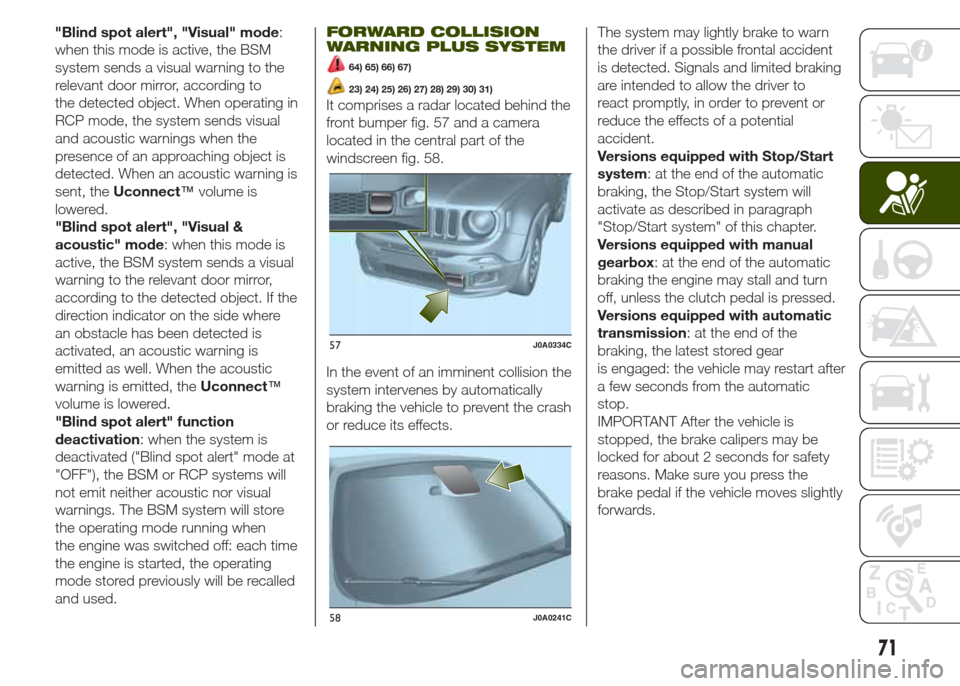
"Blind spot alert", "Visual" mode:
when this mode is active, the BSM
system sends a visual warning to the
relevant door mirror, according to
the detected object. When operating in
RCP mode, the system sends visual
and acoustic warnings when the
presence of an approaching object is
detected. When an acoustic warning is
sent, theUconnect™volume is
lowered.
"Blind spot alert", "Visual &
acoustic" mode: when this mode is
active, the BSM system sends a visual
warning to the relevant door mirror,
according to the detected object. If the
direction indicator on the side where
an obstacle has been detected is
activated, an acoustic warning is
emitted as well. When the acoustic
warning is emitted, theUconnect™
volume is lowered.
"Blind spot alert" function
deactivation: when the system is
deactivated ("Blind spot alert" mode at
"OFF"), the BSM or RCP systems will
not emit neither acoustic nor visual
warnings. The BSM system will store
the operating mode running when
the engine was switched off: each time
the engine is started, the operating
mode stored previously will be recalled
and used.FORWARD COLLISION
WARNING PLUS SYSTEM
64) 65) 66) 67)
23) 24) 25) 26) 27) 28) 29) 30) 31)
It comprises a radar located behind the
front bumper fig. 57 and a camera
located in the central part of the
windscreen fig. 58.
In the event of an imminent collision the
system intervenes by automatically
braking the vehicle to prevent the crash
or reduce its effects.The system may lightly brake to warn
the driver if a possible frontal accident
is detected. Signals and limited braking
are intended to allow the driver to
react promptly, in order to prevent or
reduce the effects of a potential
accident.
Versions equipped with Stop/Start
system: at the end of the automatic
braking, the Stop/Start system will
activate as described in paragraph
"Stop/Start system" of this chapter.
Versions equipped with manual
gearbox: at the end of the automatic
braking the engine may stall and turn
off, unless the clutch pedal is pressed.
Versions equipped with automatic
transmission: at the end of the
braking, the latest stored gear
is engaged: the vehicle may restart after
a few seconds from the automatic
stop.
IMPORTANT After the vehicle is
stopped, the brake calipers may be
locked for about 2 seconds for safety
reasons. Make sure you press the
brake pedal if the vehicle moves slightly
forwards.
57J0A0334C
58J0A0241C
71
Page 74 of 212

Activation/deactivation
The Forward Collision Warning Plus
system can be deactivated (and then
reactivated) via theUconnect™
system. The system can also
be deactivated bringing the ignition
device to MAR.
IMPORTANT The system status can be
changed with vehicle at a standstill
only.
Activation/deactivation
If the Forward Collision Warning Plus
system has been correctly activated
with theUconnect™system, this will
be active each time the engine is
started.
To deactivate the system, hold the
button on the central tunnel pressed.
Following a deactivation, the system
will not warn the driver about the
possible collision with the preceding
vehicle, regardless of the setting
selected with theUconnect™system.
To reactivate the system press the
button again.
The system only works if:
❒it is activated via theUconnect™
system;
❒it has not been deactivated with a
long press of the
button;
❒the ignition device is at MAR;❒the vehicle speed is between 7 and
200 km/h;
❒the front seat belts are fastened.
System limited operation
signal
If the dedicated message is displayed,
a condition limiting the system
operation may have occurred. The
possible reasons of this limitation are
something blocking the camera view or
a fault. If an obstruction is signalled,
clean the area of the windscreen
indicated in fig. 58 and check that the
message has disappeared.
In this case the system might be not
completely available.
When the conditions limiting the system
functions end, this will go back to a
normal and complete operation. Should
the fault persist, contact a Jeep
Dealership.
Driving in special conditions
In certain driving conditions, such as,
for example:
❒driving close to a bend (see fig. 59);
❒vehicles with small dimensions
and/or not aligned in the driving lane
(see fig. 60);
❒lane change by other vehicles (see
fig. 61);
❒vehicle driving in a transverse way
(see fig. 62);system intervention might be
unexpected or delayed. The driver must
be very careful, keeping control of the
vehicle to drive in complete safety.
59J0A0081C
60J0A0082C
72
SAFETY
Page 76 of 212
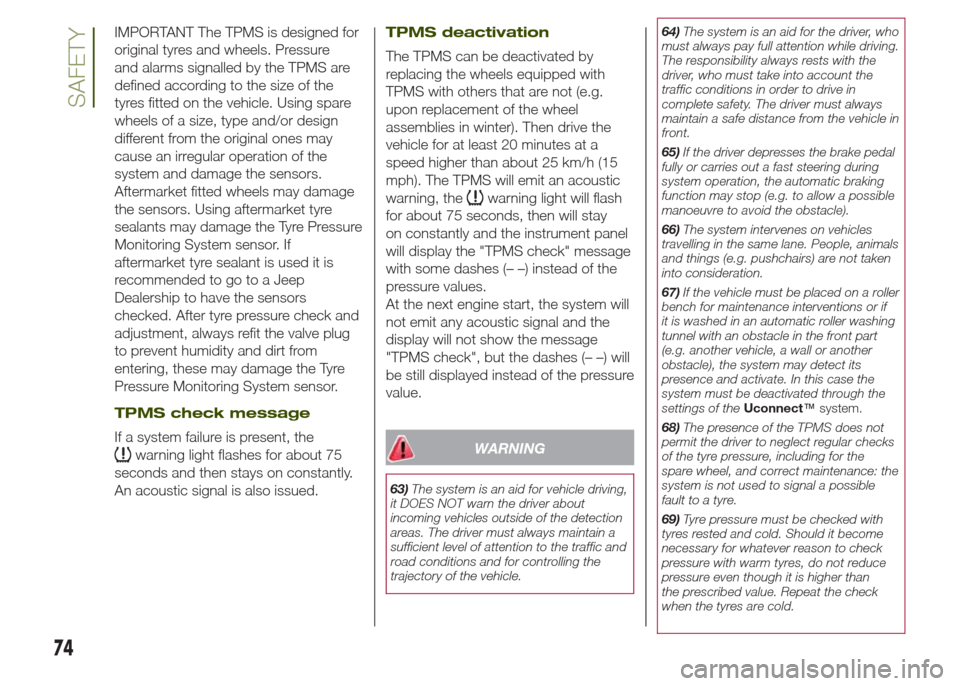
IMPORTANT The TPMS is designed for
original tyres and wheels. Pressure
and alarms signalled by the TPMS are
defined according to the size of the
tyres fitted on the vehicle. Using spare
wheels of a size, type and/or design
different from the original ones may
cause an irregular operation of the
system and damage the sensors.
Aftermarket fitted wheels may damage
the sensors. Using aftermarket tyre
sealants may damage the Tyre Pressure
Monitoring System sensor. If
aftermarket tyre sealant is used it is
recommended to go to a Jeep
Dealership to have the sensors
checked. After tyre pressure check and
adjustment, always refit the valve plug
to prevent humidity and dirt from
entering, these may damage the Tyre
Pressure Monitoring System sensor.
TPMS check message
If a system failure is present, the
warning light flashes for about 75
seconds and then stays on constantly.
An acoustic signal is also issued.
TPMS deactivation
The TPMS can be deactivated by
replacing the wheels equipped with
TPMS with others that are not (e.g.
upon replacement of the wheel
assemblies in winter). Then drive the
vehicle for at least 20 minutes at a
speed higher than about 25 km/h (15
mph). The TPMS will emit an acoustic
warning, the
warning light will flash
for about 75 seconds, then will stay
on constantly and the instrument panel
will display the "TPMS check" message
with some dashes (– –) instead of the
pressure values.
At the next engine start, the system will
not emit any acoustic signal and the
display will not show the message
"TPMS check", but the dashes (– –) will
be still displayed instead of the pressure
value.
WARNING
63)The system is an aid for vehicle driving,
it DOES NOT warn the driver about
incoming vehicles outside of the detection
areas. The driver must always maintain a
sufficient level of attention to the traffic and
road conditions and for controlling the
trajectory of the vehicle.64)The system is an aid for the driver, who
must always pay full attention while driving.
The responsibility always rests with the
driver, who must take into account the
traffic conditions in order to drive in
complete safety. The driver must always
maintain a safe distance from the vehicle in
front.
65)If the driver depresses the brake pedal
fully or carries out a fast steering during
system operation, the automatic braking
function may stop (e.g. to allow a possible
manoeuvre to avoid the obstacle).
66)The system intervenes on vehicles
travelling in the same lane. People, animals
and things (e.g. pushchairs) are not taken
into consideration.
67)If the vehicle must be placed on a roller
bench for maintenance interventions or if
it is washed in an automatic roller washing
tunnel with an obstacle in the front part
(e.g. another vehicle, a wall or another
obstacle), the system may detect its
presence and activate. In this case the
system must be deactivated through the
settings of theUconnect™system.
68)The presence of the TPMS does not
permit the driver to neglect regular checks
of the tyre pressure, including for the
spare wheel, and correct maintenance: the
system is not used to signal a possible
fault to a tyre.
69)Tyre pressure must be checked with
tyres rested and cold. Should it become
necessary for whatever reason to check
pressure with warm tyres, do not reduce
pressure even though it is higher than
the prescribed value. Repeat the check
when the tyres are cold.
74
SAFETY
Page 98 of 212
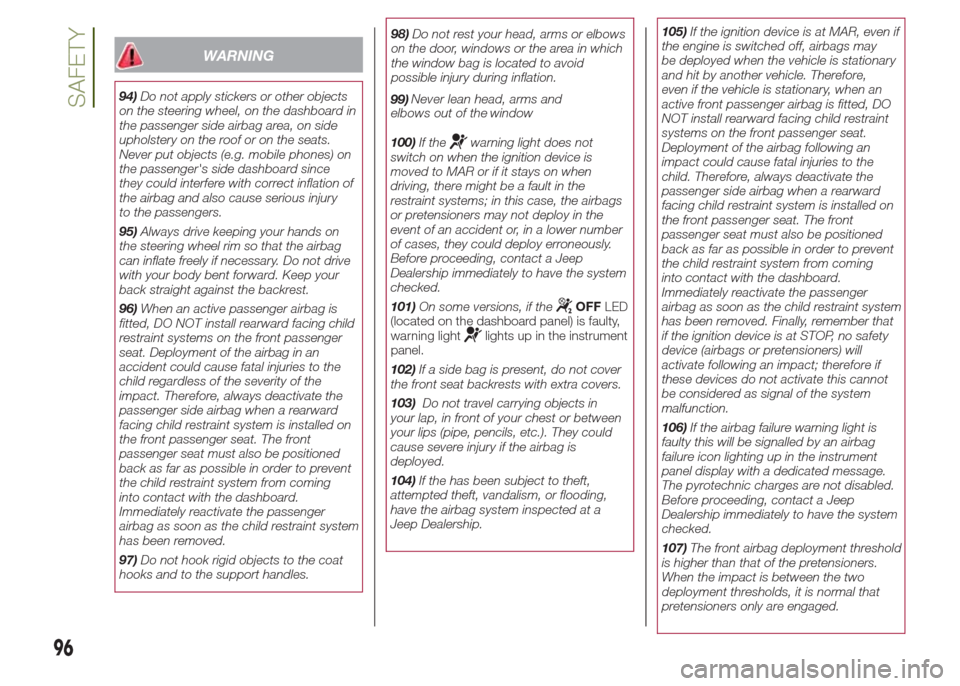
WARNING
94)Do not apply stickers or other objects
on the steering wheel, on the dashboard in
the passenger side airbag area, on side
upholstery on the roof or on the seats.
Never put objects (e.g. mobile phones) on
the passenger's side dashboard since
they could interfere with correct inflation of
the airbag and also cause serious injury
to the passengers.
95)Always drive keeping your hands on
the steering wheel rim so that the airbag
can inflate freely if necessary. Do not drive
with your body bent forward. Keep your
back straight against the backrest.
96)When an active passenger airbag is
fitted, DO NOT install rearward facing child
restraint systems on the front passenger
seat. Deployment of the airbag in an
accident could cause fatal injuries to the
child regardless of the severity of the
impact. Therefore, always deactivate the
passenger side airbag when a rearward
facing child restraint system is installed on
the front passenger seat. The front
passenger seat must also be positioned
back as far as possible in order to prevent
the child restraint system from coming
into contact with the dashboard.
Immediately reactivate the passenger
airbag as soon as the child restraint system
has been removed.
97)Do not hook rigid objects to the coat
hooks and to the support handles.100)If the
warning light does not
switch on when the ignition device is
moved to MAR or if it stays on when
driving, there might be a fault in the
restraint systems; in this case, the airbags
or pretensioners may not deploy in the
event of an accident or, in a lower number
of cases, they could deploy erroneously.
Before proceeding, contact a Jeep
Dealership immediately to have the system
checked.
101)On some versions, if the
OFFLED
(located on the dashboard panel) is faulty,
warning light
lights up in the instrument
panel.
102)If a side bag is present, do not cover
the front seat backrests with extra covers.
103)Do not travel carrying objects in
your lap, in front of your chest or between
your lips (pipe, pencils, etc.). They could
cause severe injury if the airbag is
deployed.
104)If the has been subject to theft,
attempted theft, vandalism, or flooding,
have the airbag system inspected at a
Jeep Dealership.105)If the ignition device is at MAR, even if
the engine is switched off, airbags may
be deployed when the vehicle is stationary
and hit by another vehicle. Therefore,
even if the vehicle is stationary, when an
active front passenger airbag is fitted, DO
NOT install rearward facing child restraint
systems on the front passenger seat.
Deployment of the airbag following an
impact could cause fatal injuries to the
child. Therefore, always deactivate the
passenger side airbag when a rearward
facing child restraint system is installed on
the front passenger seat. The front
passenger seat must also be positioned
back as far as possible in order to prevent
the child restraint system from coming
into contact with the dashboard.
Immediately reactivate the passenger
airbag as soon as the child restraint system
has been removed. Finally, remember that
if the ignition device is at STOP, no safety
device (airbags or pretensioners) will
activate following an impact; therefore if
these devices do not activate this cannot
be considered as signal of the system
malfunction.
106)If the airbag failure warning light is
faulty this will be signalled by an airbag
failure icon lighting up in the instrument
panel display with a dedicated message.
The pyrotechnic charges are not disabled.
Before proceeding, contact a Jeep
Dealership immediately to have the system
checked.
107)The front airbag deployment threshold
is higher than that of the pretensioners.
When the impact is between the two
deployment thresholds, it is normal that
pretensioners only are engaged.
96
SAFETY
98)Do not rest your head, arms or elbows
on the door, windows or the area in which
the window bag is located to avoid
possible injury during inflation.
99)
elbows out of the windowNever lean head, arms and
Page 100 of 212
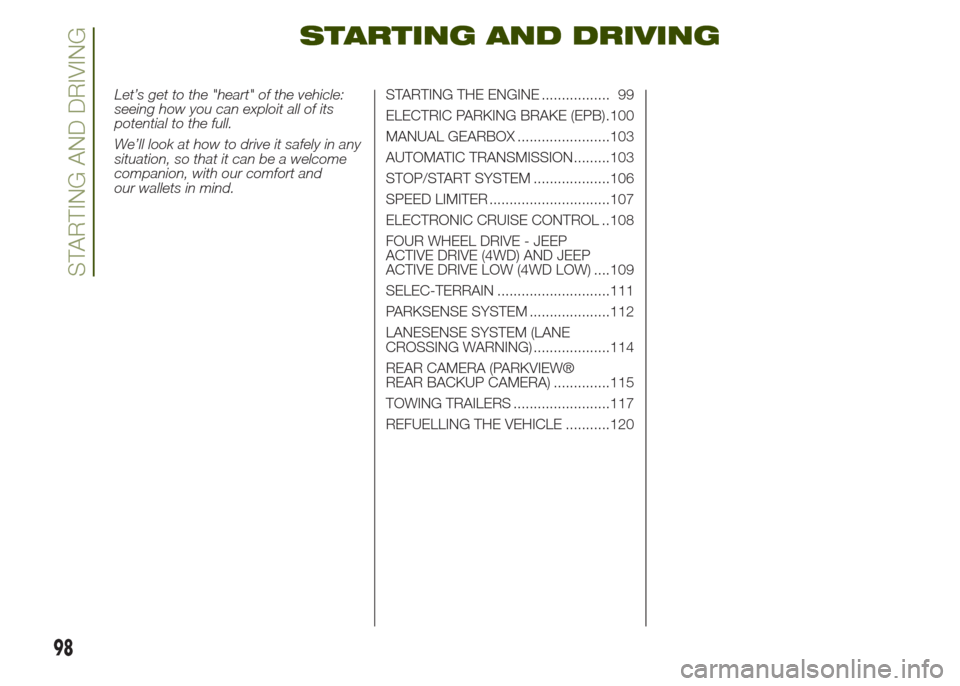
STARTING AND DRIVING
Let’s get to the "heart" of the vehicle:
seeing how you can exploit all of its
potential to the full.
We’ll look at how to drive it safely in any
situation, so that it can be a welcome
companion, with our comfort and
our wallets in mind.STARTING THE ENGINE ................. 99
ELECTRIC PARKING BRAKE (EPB).100
MANUAL GEARBOX .......................103
AUTOMATIC TRANSMISSION.........103
STOP/START SYSTEM ...................106
SPEED LIMITER ..............................107
ELECTRONIC CRUISE CONTROL ..108
FOUR WHEEL DRIVE - JEEP
ACTIVE DRIVE (4WD) AND JEEP
ACTIVE DRIVE LOW (4WD LOW) ....109
SELEC-TERRAIN ............................111
PARKSENSE SYSTEM ....................112
LANESENSE SYSTEM (LANE
CROSSING WARNING) ...................114
REAR CAMERA (PARKVIEW®
REAR BACKUP CAMERA) ..............115
TOWING TRAILERS ........................117
REFUELLING THE VEHICLE ...........120
98
STARTING AND DRIVING
Page 101 of 212
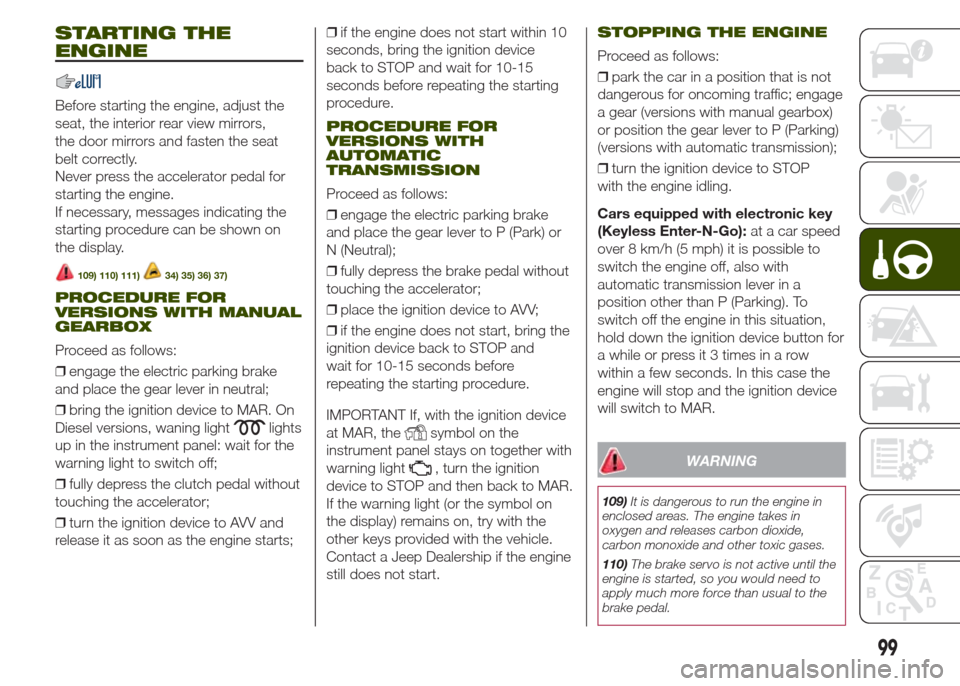
STARTING THE
ENGINE
Before starting the engine, adjust the
seat, the interior rear view mirrors,
the door mirrors and fasten the seat
belt correctly.
Never press the accelerator pedal for
starting the engine.
If necessary, messages indicating the
starting procedure can be shown on
the display.
109) 110) 111)34) 35) 36) 37)
PROCEDURE FOR
VERSIONS WITH MANUAL
GEARBOX
Proceed as follows:
❒engage the electric parking brake
and place the gear lever in neutral;
❒bring the ignition device to MAR. On
Diesel versions, waning light
lights
up in the instrument panel: wait for the
warning light to switch off;
❒fully depress the clutch pedal without
touching the accelerator;
❒turn the ignition device to AVV and
release it as soon as the engine starts;❒if the engine does not start within 10
seconds, bring the ignition device
back to STOP and wait for 10-15
seconds before repeating the starting
procedure.
PROCEDURE FOR
VERSIONS WITH
AUTOMATIC
TRANSMISSION
Proceed as follows:
❒engage the electric parking brake
and place the gear lever to P (Park) or
N (Neutral);
❒fully depress the brake pedal without
touching the accelerator;
❒place the ignition device to AVV;
❒if the engine does not start, bring the
ignition device back to STOP and
wait for 10-15 seconds before
repeating the starting procedure.
IMPORTANT If, with the ignition device
at MAR, the
symbol on the
instrument panel stays on together with
warning light
, turn the ignition
device to STOP and then back to MAR.
If the warning light (or the symbol on
the display) remains on, try with the
other keys provided with the vehicle.
Contact a Jeep Dealership if the engine
still does not start.
STOPPING THE ENGINE
Proceed as follows:
❒park the car in a position that is not
dangerous for oncoming traffic; engage
a gear (versions with manual gearbox)
or position the gear lever to P (Parking)
(versions with automatic transmission);
❒turn the ignition device to STOP
with the engine idling.
Cars equipped with electronic key
(Keyless Enter-N-Go):at a car speed
over 8 km/h (5 mph) it is possible to
switch the engine off, also with
automatic transmission lever in a
position other than P (Parking). To
switch off the engine in this situation,
hold down the ignition device button for
a while or press it 3 times in a row
within a few seconds. In this case the
engine will stop and the ignition device
will switch to MAR.
WARNING
109)It is dangerous to run the engine in
enclosed areas. The engine takes in
oxygen and releases carbon dioxide,
carbon monoxide and other toxic gases.
110)The brake servo is not active until the
engine is started, so you would need to
apply much more force than usual to the
brake pedal.
99
Page 102 of 212
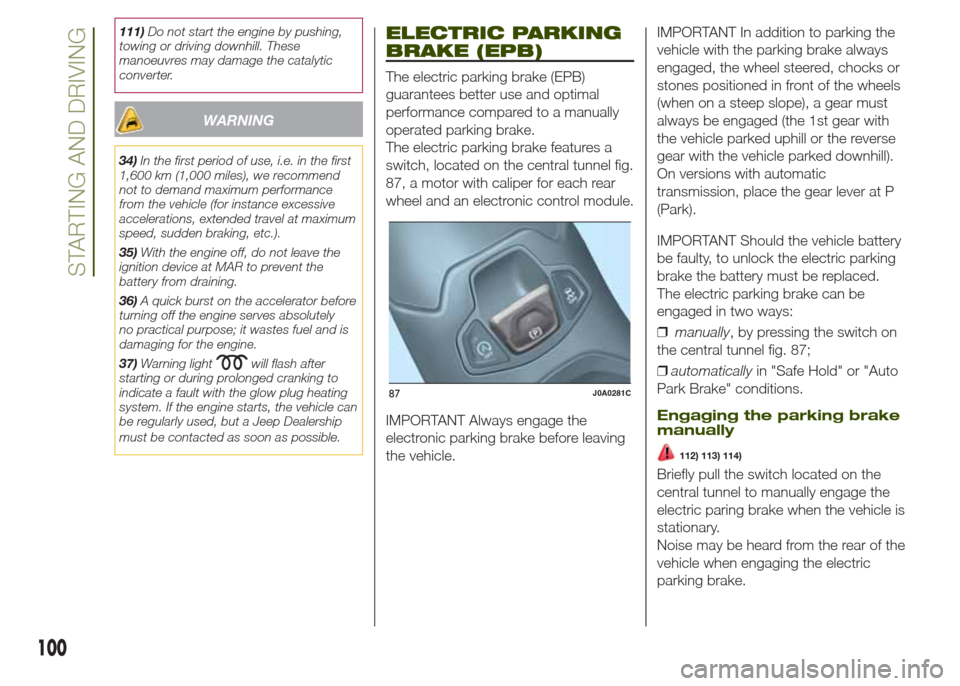
111)Do not start the engine by pushing,
towing or driving downhill. These
manoeuvres may damage the catalytic
converter.
WARNING
34)In the first period of use, i.e. in the first
1,600 km (1,000 miles), we recommend
not to demand maximum performance
from the vehicle (for instance excessive
accelerations, extended travel at maximum
speed, sudden braking, etc.).
35)With the engine off, do not leave the
ignition device at MAR to prevent the
battery from draining.
36)A quick burst on the accelerator before
turning off the engine serves absolutely
no practical purpose; it wastes fuel and is
damaging for the engine.
37)Warning light
will flash after
starting or during prolonged cranking to
indicate a fault with the glow plug heating
system. If the engine starts, the vehicle can
be regularly used, but a Jeep Dealership
must be contacted as soon as possible.
ELECTRIC PARKING
BRAKE (EPB)
The electric parking brake (EPB)
guarantees better use and optimal
performance compared to a manually
operated parking brake.
The electric parking brake features a
switch, located on the central tunnel fig.
87, a motor with caliper for each rear
wheel and an electronic control module.
IMPORTANT Always engage the
electronic parking brake before leaving
the vehicle.IMPORTANT In addition to parking the
vehicle with the parking brake always
engaged, the wheel steered, chocks or
stones positioned in front of the wheels
(when on a steep slope), a gear must
always be engaged (the 1st gear with
the vehicle parked uphill or the reverse
gear with the vehicle parked downhill).
On versions with automatic
transmission, place the gear lever at P
(Park).
IMPORTANT Should the vehicle battery
be faulty, to unlock the electric parking
brake the battery must be replaced.
The electric parking brake can be
engaged in two ways:
❒manually, by pressing the switch on
the central tunnel fig. 87;
❒automaticallyin "Safe Hold" or "Auto
Park Brake" conditions.
Engaging the parking brake
manually
112) 113) 114)
Briefly pull the switch located on the
central tunnel to manually engage the
electric paring brake when the vehicle is
stationary.
Noise may be heard from the rear of the
vehicle when engaging the electric
parking brake.
87J0A0281C
100
STARTING AND DRIVING
Page 105 of 212
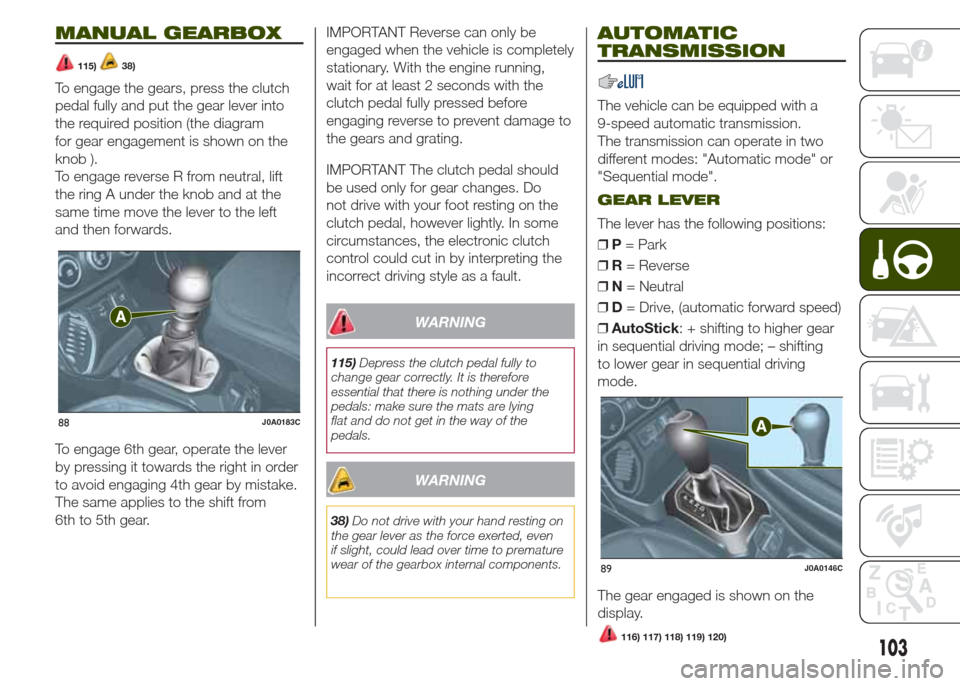
MANUAL GEARBOX
115)38)
To engage the gears, press the clutch
pedal fully and put the gear lever into
the required position (the diagram
for gear engagement is shown on the
knob ).
To engage reverse R from neutral, lift
the ring A under the knob and at the
same time move the lever to the left
and then forwards.
To engage 6th gear, operate the lever
by pressing it towards the right in order
to avoid engaging 4th gear by mistake.
The same applies to the shift from
6th to 5th gear.IMPORTANT Reverse can only be
engaged when the vehicle is completely
stationary. With the engine running,
wait for at least 2 seconds with the
clutch pedal fully pressed before
engaging reverse to prevent damage to
the gears and grating.
IMPORTANT The clutch pedal should
be used only for gear changes. Do
not drive with your foot resting on the
clutch pedal, however lightly. In some
circumstances, the electronic clutch
control could cut in by interpreting the
incorrect driving style as a fault.
WARNING
115)Depress the clutch pedal fully to
change gear correctly. It is therefore
essential that there is nothing under the
pedals: make sure the mats are lying
flat and do not get in the way of the
pedals.
WARNING
38)Do not drive with your hand resting on
the gear lever as the force exerted, even
if slight, could lead over time to premature
wear of the gearbox internal components.
AUTOMATIC
TRANSMISSION
The vehicle can be equipped with a
9-speed automatic transmission.
The transmission can operate in two
different modes: "Automatic mode" or
"Sequential mode".
GEAR LEVER
The lever has the following positions:
❒P= Park
❒R= Reverse
❒N= Neutral
❒D= Drive, (automatic forward speed)
❒AutoStick: + shifting to higher gear
in sequential driving mode; – shifting
to lower gear in sequential driving
mode.
The gear engaged is shown on the
display.
88J0A0183C
89J0A0146C
103116) 117) 118) 119) 120)
Page 106 of 212
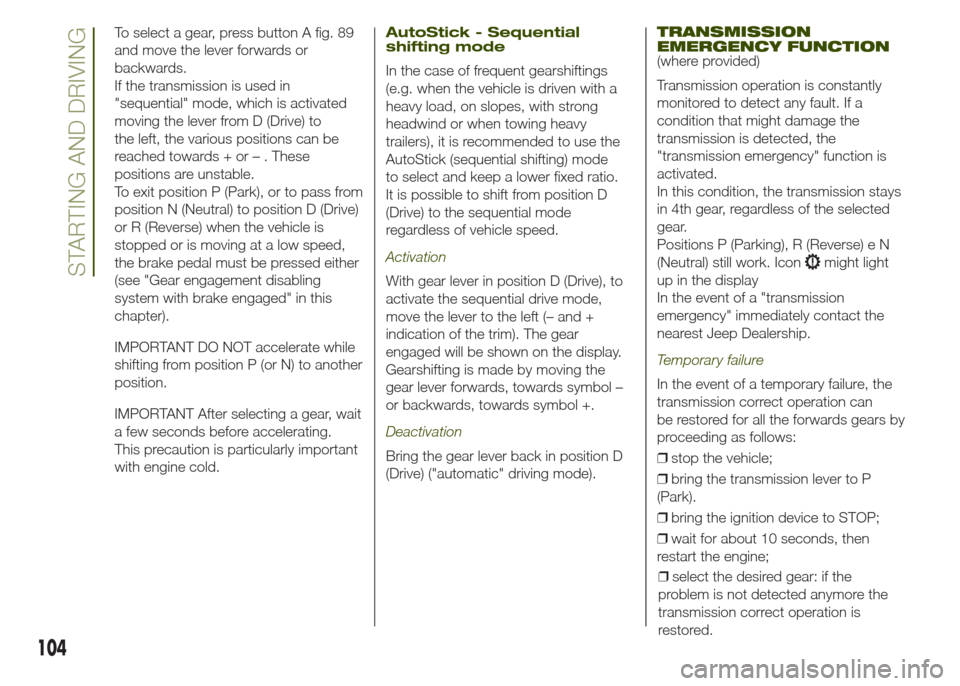
To select a gear, press button A fig. 89
and move the lever forwards or
backwards.
If the transmission is used in
"sequential" mode, which is activated
moving the lever from D (Drive) to
the left, the various positions can be
reached towards + or – . These
positions are unstable.
To exit position P (Park), or to pass from
position N (Neutral) to position D (Drive)
or R (Reverse) when the vehicle is
stopped or is moving at a low speed,
the brake pedal must be pressed either
(see "Gear engagement disabling
system with brake engaged" in this
chapter).
IMPORTANT DO NOT accelerate while
shifting from position P (or N) to another
position.
IMPORTANT After selecting a gear, wait
a few seconds before accelerating.
This precaution is particularly important
with engine cold.AutoStick - Sequential
shifting mode
In the case of frequent gearshiftings
(e.g. when the vehicle is driven with a
heavy load, on slopes, with strong
headwind or when towing heavy
trailers), it is recommended to use the
AutoStick (sequential shifting) mode
to select and keep a lower fixed ratio.
It is possible to shift from position D
(Drive) to the sequential mode
regardless of vehicle speed.
Activation
With gear lever in position D (Drive), to
activate the sequential drive mode,
move the lever to the left (– and +
indication of the trim). The gear
engaged will be shown on the display.
Gearshifting is made by moving the
gear lever forwards, towards symbol –
or backwards, towards symbol +.
Deactivation
Bring the gear lever back in position D
(Drive) ("automatic" driving mode).
TRANSMISSION
EMERGENCY FUNCTION
(where provided)
Transmission operation is constantly
monitored to detect any fault. If a
condition that might damage the
transmission is detected, the
"transmission emergency" function is
activated.
In this condition, the transmission stays
in 4th gear, regardless of the selected
gear.
Positions P (Parking), R (Reverse) e N
(Neutral) still work. Icon
might light
up in the display
In the event of a "transmission
emergency" immediately contact the
nearest Jeep Dealership.
Temporary failure
In the event of a temporary failure, the
transmission correct operation can
be restored for all the forwards gears by
proceeding as follows:
❒stop the vehicle;
❒bring the transmission lever to P
(Park).
❒bring the ignition device to STOP;
❒wait for about 10 seconds, then
restart the engine;
104
STARTING AND DRIVING
❒select the desired gear: if the
problem is not detected anymore the
transmission correct operation is
restored.